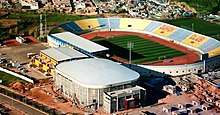Duhok
Duhok, also spelled Dihok (Kurdish: Dihok, دهۆک,[2][3] Syriac: ܒܝܬ ܢܘܗܕܪܐ, romanized: Bet Nohadra[4][5][6]) is the capital of the Duhok Governorate in Iraq's Kurdistan Region. The city is encircled by mountains along the Tigris river. Duhok has a growing tourist industry. Its population has increased rapidly since the 1990s, as the rural population moved to the cities after villages were destroyed by the Iraqi Army during the 1991 uprisings in Iraq. The University of Duhok, founded in 1992, is a renowned center for teaching and research. The city of Duhok is populated by Kurds and Assyrians.
Duhok Dihok, دهۆک ܢܘܗܕܪܐ | |
|---|---|
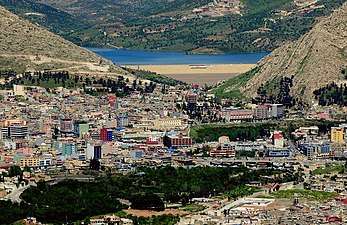 View on Duhok with the Duhok Dam in the background | |
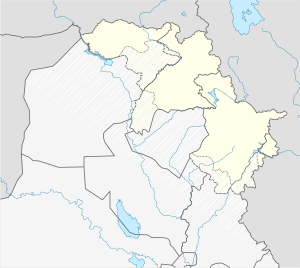 Duhok Kurdistan Region (yellow) 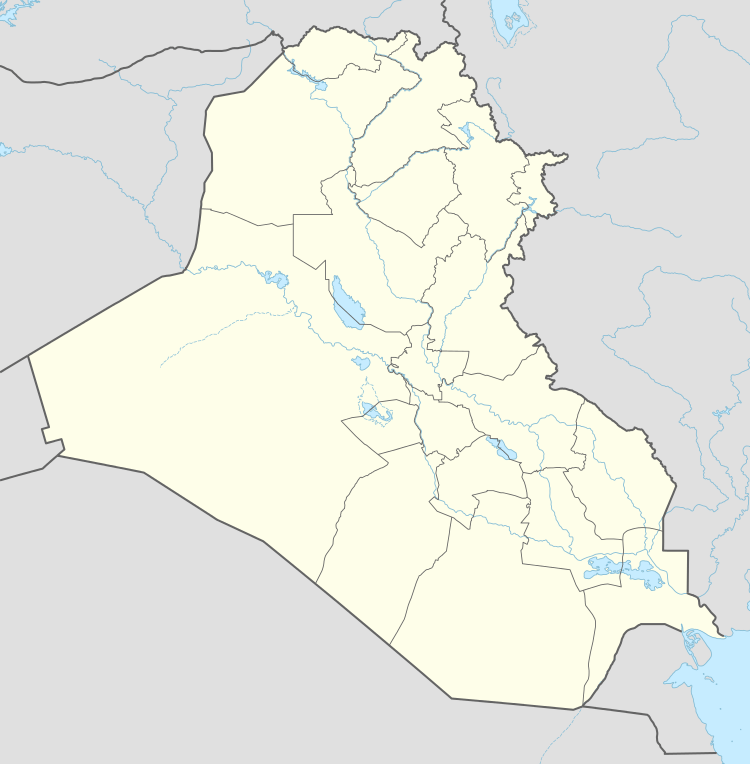 Duhok Duhok (Iraq) | |
| Coordinates: 36°52′N 43°0′E | |
| Country | |
| Autonomous region | |
| Governorate | Duhok Governorate |
| District | Duhok District |
| Government | |
| • Mayor | Ali Tattar |
| Elevation | 1,854 ft (565 m) |
| Population (2018) | |
| • Total | 340,900+[1] |
| Time zone | UTC+3 (Arabian Standard Time) |
| Postcode | 42001 |
| Area code(s) | 062 |
| Website | http://duhok.gov.krd |
Duhok Governorate contains many mosques and historical shrines and tombs built during the Ayyubid period and historical sites from the Guti Medes, and still exist in the present, including the Great Duhok Mosque, the Azadi Mosque, the Saladin Salah Din Al - Ayoubi Mosque and the Great Mosque in Akre. It also has historical churches such as the Mar Odisho Church in the village of Dooreh (located in the Amadiya District), the Church of Mart Shmoni and the Church of Sultana Mahdokht (established in 325 AD) in the village of Araden.
History
Throughout history to the present time, Duhok has acquired a strategic position historically and geographically. Between the 25th and 22nd century BC, it changed hands between the Akkadians, Sumerians, Assyrians, Amorites, Gutians, Hurrians and Hattians, before becoming an integral part of Assyria from the mid 21st century BC until the dissolution of Assyria (then known as Athura/Assuristan) in the mid 7th century AD after the Arab Islamic Conquest.[7]
During the Assyrian period the town was named Nohadra (and also Bit Nuhadra or Naarda). During Parthian-Sassanid rule in Assyria (c. 160 BC to 250 AD) Beth Nuhadra gained semi-independence as one of a patchwork of Neo-Assyrian kingdoms in Assyria, which also included Adiabene, Osroene, Assur and Beth Garmai. During the Christian era it became an eparchy within the Assyrian Church of the East metropolitanate of Ḥadyab (Erbil).[8][9]
The city became prominent again in 1236, when Hasan Beg Saifadin joined the Kurdish Badinan principality. In 1842, the principality was dissolved by the Ottomans and the region administered from the city of Mosul.[10]
In 1898 there were eleven small private schools in the city, including two Assyrian and two Jewish schools. In 1920 there were, in all of Iraq, only five primary schools that were accessible for girls, and one of them was in Duhok.
In September 2005, Duhok held a cultural festival for the first time to which Kurdish writers from many countries were invited. Duhok has been a center for many refugees since 2014 as the Kurdistan Regional Government was the only part of Iraq to take in both Iraqi and Syrian refugees.
Demographics
Multiple travelers commented on its ethnic composition in the 19th and early 20th century.
In 1820, Rich described it as a small town of 300 houses, which was the principal site of the Doski tribe, together with eighty other villages. The missionary Henry Aaron Stern (1851) commented on Duhok's mixed population and noted that it included Jewish residents, adding that the kiahya, or mayor of the village, was a Chaldean Catholic. In 1859, Rabbi Yehiel found there two minyans of Jews. The Muslims and Christians formed about a hundred households. In 1929, its settled population was about 3,500 inhabitants, with Kurds forming the majority. Out of the 550 households, 65 were Christian and 30 were Jewish. A sizeable number of Nestorian refugees previously from Tiyari and a lesser number of Chaldeans from the Turkish districts of Merga and Bothan migrated into Duhok in the aftermath of World War I. In 1929, the qada of Duhok had a mixed population of 29,858, composed mostly of Muslim Kurds (18,307), Christians 5,784 (19.3%), Muslim Arabs 2,068, Yezidis 2,870, and Jews 829 (2.7%).[11]
The city's population is 340,000. It consists mostly of Kurds with a significant Assyrian community. The Assyrians of Duhok boast one of the largest churches in the region, the Mar Marsi Cathedral, and is the center of an eparchy.[12] Tens of thousands of Yazidi and Assyrian Christian internally displaced persons (IDPs) live in the city as well due to the Islamic State of Iraq and the Levant (ISIL) expansion in Iraq in 2014 and the subsequent Fall of Mosul and the Nineveh Plains region after two more months of fighting, in addition to the Sinjar massacre in which 5,000 Yezidis were massacred during the genocide of Yazidis by ISIL.[13][14] According to the International Organization for Migration (IOM-Iraq), as of June 2019, Duhok Governorate hosted 326,106 IDPs across 169 different locations.[15]
Educational institutions
Educational institutions in Duhok include:
- University of Duhok
- Duhok Polytechnic University
- Nawroz University
- Duhok Private Technical Institute
- University of Cihan
- Sardam International School
- Da Vinci World School
- Da Vinci institute
Sport
The city is home to several sporting clubs including Duhok SC, a professional football club that plays in the Iraqi Premier League. Another football team from the city is Zeravani SC, which plays in the Kurdish Premier League. Duhok also has a range of other sport clubs, including the Duhok Basketball Club. Duhok SC Basketball competes in the Iraqi Division I Basketball League and came third in FIBA Asia Champions Cup in 2012.
Duhok SC won the Iraqi Premier League championship for the first time in the 2009/2010 season, beating Al-Talaba SC 1–0.
Climate
According to the Köppen-Geiger climate classification system, Duhok has a borderline semi-arid (BSh) and Mediterranean climate (Csa) with extremely hot, prolonged, dry summers and mild to cool, wet winters, similar to most of Upper Mesopotamia. Precipitation falls in the cooler months, being heaviest in late winter and early spring. The city can get around two or three snowy days per year, with heavier falls in the uplands. Summers are virtually dry, with rain returning in late autumn.
| Climate data for Duhok, Iraq | |||||||||||||
|---|---|---|---|---|---|---|---|---|---|---|---|---|---|
| Month | Jan | Feb | Mar | Apr | May | Jun | Jul | Aug | Sep | Oct | Nov | Dec | Year |
| Record high °C (°F) | 20 (68) |
27 (81) |
30 (86) |
34 (93) |
38 (100) |
41 (106) |
45 (113) |
46 (115) |
44 (111) |
39 (102) |
31 (88) |
24 (75) |
46 (115) |
| Average high °C (°F) | 11 (52) |
14 (57) |
19 (66) |
24 (75) |
32 (90) |
38 (100) |
42 (108) |
41 (106) |
37 (99) |
29 (84) |
20 (68) |
13 (55) |
27 (80) |
| Daily mean °C (°F) | 7 (45) |
10 (50) |
14 (57) |
18 (64) |
25 (77) |
31 (88) |
34 (93) |
34 (93) |
29 (84) |
22 (72) |
14 (57) |
9 (48) |
21 (69) |
| Average low °C (°F) | 3 (37) |
5 (41) |
9 (48) |
13 (55) |
18 (64) |
23 (73) |
27 (81) |
26 (79) |
21 (70) |
15 (59) |
8 (46) |
6 (43) |
15 (58) |
| Record low °C (°F) | −4 (25) |
−6 (21) |
−1 (30) |
3 (37) |
6 (43) |
10 (50) |
13 (55) |
17 (63) |
11 (52) |
4 (39) |
−2 (28) |
−2 (28) |
−6 (21) |
| Average rainfall mm (inches) | 101 (4.0) |
120 (4.7) |
111 (4.4) |
70 (2.8) |
38 (1.5) |
0 (0) |
0 (0) |
0 (0) |
1 (0.0) |
10 (0.4) |
57 (2.2) |
108 (4.3) |
616 (24.3) |
| Average precipitation days | 9 | 9 | 10 | 9 | 4 | 1 | 0 | 0 | 1 | 3 | 6 | 10 | 62 |
| Average snowy days | 1 | 0 | — | 0 | 0 | 0 | 0 | 0 | 0 | 0 | 0 | — | — |
| Average relative humidity (%) | 60 | 53 | 46 | 39 | 23 | 15 | 13 | 15 | 17 | 28 | 42 | 62 | 34 |
| Source 1: My Forecast[16] | |||||||||||||
| Source 2: Levoyageur for rainfall[17] | |||||||||||||
Exhibition

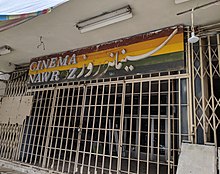
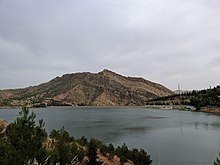
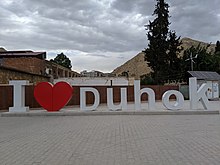
References
- "Iraq: Governorates, Major Cities & Urban Centers - Population Statistics, Maps, Charts, Weather and Web Information". www.citypopulation.de.
- "K24 rêjeya dengdanê li navçeyên cuda yên Herêma Kurdistan belav kir". Kurdistan24 (in Kurdish). Retrieved 18 December 2019.
- "كوردستانی سەرسوڕهێنەر- وێبسایتی فەرمی دەستەی گشتی گەشت و گوزار". bot.gov.krd. Retrieved 18 December 2019.
- Kadr, Salahden Ghareb (2010). Klimatische Optimierung von verdichteten Wohnhäusern in Irakisch-Kurdistan (in German). Univerlagtuberlin. ISBN 978-3-7983-2238-7.
- Scheler, Claudia Rammelt (Hg ) in Verbindung mit Jan Gehm und Rebekka (2019-04-26). Pluralität und Koexistenz, Gewalt, Flucht und Vertreibung: Christliche, jesidische und muslimische Lebenswelten in den gegenwärtigen Umbrüchen im Nahen Osten (in German). LIT Verlag Münster. ISBN 978-3-643-14293-1.
- Thomas A. Carlson et al., “Duhok — ܒܝܬ ܢܘܗܕܪܐ ” in The Syriac Gazetteer last modified February 6, 2014, http://syriaca.org/place/76.
- http://www.uod.ac/site/en/duhokcity#sthash.m1dKO7nV.dpuf Archived 2014-12-18 at the Wayback Machine
- Société des études arméniennes, Fundação Calouste Gulbenkian, Association de la revue des études arméniennes (1989). Revue des études arméniennes, Volume 21. pp. 303, 309.CS1 maint: multiple names: authors list (link)
- NAARDA, Dictionary of Greek and Roman Geography (1854)
- BAHDĪNĀN. "Encyclopaedia Iranica". www.iranicaonline.org.
- M. Zaken, Jewish Subjects and Their Tribal Chieftains in Kurdistan, 376 pp., Brill, 2007.
- Mar Narsi church. "Dhouk". www.ishtartv.com.
- Khalel, Sheren; Vickery, Matthew (27 October 2014). "The Forgotten Yazidis". Foreign Policy Magazine.
- Interactive. "Iraq's exodus". www.aljazeera.com.
- "DTM-IOM-Iraq Mission". iraqdtm.iom.int. Retrieved 2019-08-08.
- "Dahuk, Iraq Climate". My Forecast. Retrieved 2014-01-04.
- "Climate, weather, temperatures - City : DUHOK". Levoyageur. Retrieved 2014-01-04.
External links
| Wikimedia Commons has media related to Dohuk. |
